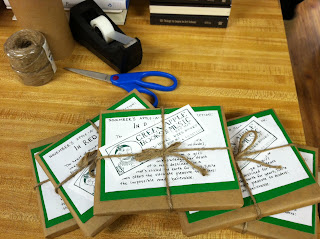
There has been a bit of a buzz amongst booksellers about this recent Dan Clowes New Yorker cover. It would seem to disparage bookstores not only for carrying all sorts of knick knacks and gewgaws aside from books, but for pushing the books farther to the back of the store.
Now, it is a nearly universal fact that bookstores are carrying all sorts of "sidelines" that you wouldn't have seen in a "bookstore" 10 years ago. Even City Lights is selling
onesies (very cute). At Green Apple, we've added all sorts of toys and games and puzzles to the mix over the last few years. When Raymond Carver lived in the neighborhood in the 1970's, he didn't ponder whether to add a refrigerator magnet or some
finger tentacles to his purchases. But a business has to do what a business has to do to stay in business, and if finger tentacles help keep the lights on, then bring on the finger tentacles.
But Mr. Clowes does have a point, I believe. With the advent of e-books, there is much discussion (see
here and
here) about the future of books and bookstores. As more and more people read their books digitally, which is inevitable, then whither the bookstore. I'm not going to make an argument for the many positive things a bookstore brings to a community. I just want to stick to the reality that they are endangered. Every single person doesn't have to buy a Kindle to make the neighborhood bookstore go the way of the typewriter shop, just enough of them so that it no longer becomes a viable business to sell books for a living.
Which brings us to my answer to the question, what will become of the bookstore? As digital reading slowly (or quickly) replaces the reading of paper books, those sidelines will continue to expand and multiply, until what we consider a "bookstore" will actually be a gift shop or a clothing store or some other type of general merchandise emporium that also happens to have a good selection of books. How long this will take is anybody's guess. My personal guess is that it will be much slower than some people think, as readers generally have a strong attachment to the physical book. The analogy would be to vinyl records compared to compact discs. Audiophiles still love their vinyl, and at Green Apple we are selling more vinyl now than we did ten years ago. Compact discs, nobody has an emotional attachment to, and apparently
there is talk that production of compact discs will cease all together in the next year of two. I think it will be a long slow transition from bookstore to store with books.














